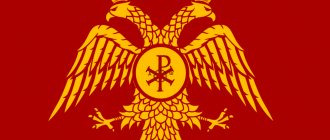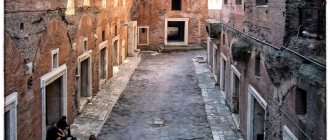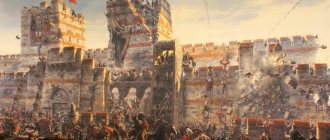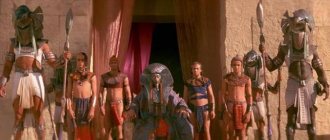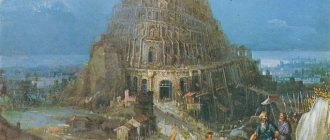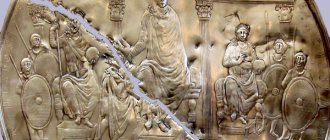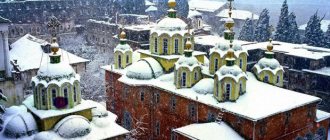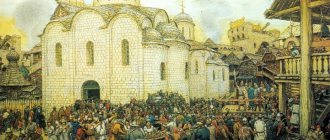The fall of Constantinople is a story filled with pathos. The last emperor of Byzantium rushing into battle to die, a giant bronze cannon shooting half-ton cannonballs, a floating fortress raining down flamethrowers on enemies, the betrayal of Europe, a young empire devouring a decrepit one - it’s hard to imagine something more pathetic.
On April 5, 1453, the Turks brought an army to Constantinople and a siege began, which ended with the fall of the Byzantine Empire and the end of its thousand-year history.
The emergence of the Byzantine Empire
The cause of the emergence of Byzantium was the collapse of the Great Roman Empire, which ended with the division into the Western and Eastern Roman Empire. The last ruler of the Roman Empire was Theodosius I. During his reign, Christianity became a single religion throughout the empire. Before his death, the emperor carried out a division into the Western and Eastern empires, each of which he gave to his sons Honorius and Arcadius.
The Western Empire was able to survive for less than a century and fell under the onslaught of barbarians in the second half of the 5th century.
Rome lost its greatness for many hundreds of years . The eastern part, centered in Constantinople (now Istanbul, Turkey), became a powerful successor, receiving the name of the Byzantine Empire.
The founding date of Constantinople falls on the year 330, when Emperor Constantine moved the capital to the place where the Greek colony of Byzantium was located.
Later, Constantinople became the capital of the Eastern Empire and the richest city of the Middle Ages. The Byzantine Empire lasted for more than 1000 years (395–1453), while the Roman Empire itself lasted 500 years.
Attention! Historians began to call the resulting empire Byzantium after its collapse in the 15th century.
The power of the Byzantine Empire was based on trade and craft production. Cities grew and developed, providing the production of all necessary goods. The sea trade route was the safest, because wars did not stop on land. Trade between East and West was carried out through Byzantium, thanks to which its ports reached their greatest prosperity, which occurred in the 5th–8th centuries.
The multinational population brought its own cultural diversity, but the ancient heritage was taken as a basis, and Greek became the main language. The majority of the population was Greek, which is why the name “Greek Empire” appeared in the west. Considering themselves the heirs of the Romans , the Greeks began to call themselves “Romans,” which means Romans in Greek, and their empire Romania.
Turkish danger
By the middle of the 15th century, the territory of Turkey expanded significantly. It was a powerful state, constantly expanding its borders to the west and east. As a result, it surrounded Byzantium on all sides. Turkey wanted to conquer Constantinople because the city was the main obstacle to its seizure of full power in the region.
During this period, Byzantium constantly waged a political struggle with Venice and Genoa. Each time, the participants in the conflict tried to win over the Ottomans to their side. This was to the advantage of Turkey, which expanded its possessions by providing them with military services.
At the same time, Europe was afraid of Turkish strengthening. At the same time, each country adhered only to its own interests. As a result, they did not provide support to Constantinople. The exception was Venice, which provided its fleet.
Rise of Byzantium
The period of greatest power of the empire occurred during the reign of Justinian in the middle of the 6th century. The empire's possessions reached their maximum limits in its history, which was achieved through military campaigns. The territory of Byzantium grew after the annexation of the southern part of Spain and Italy, the countries of North Africa.
Roman law and the norms of the Christian religion were established in the empire. The document was called the “Code of Laws”, becoming the basis for the laws of European powers.
Under the reign of Justinian, the world's most majestic Hagia Sophia was built, with splendid frescoes and a mosaic vault . Justinian's monumental imperial palace overlooked the Sea of Marmara.
The absence of barbarian raids contributed to the cultural development and growth of the power of the Byzantine Empire. Greco-Roman cities continued to exist with palaces, snow-white columns and statues. Crafts, science, and trade flourished there. The experience of Roman urban planning was borrowed, water supply and thermal baths (baths) were in operation.
Important! State symbols during the Byzantine Empire were absent or only developing.
The Palaiologan dynasty, which ruled for the last two centuries, had a purple imperial flag of Byzantium. In its center was a double-headed golden eagle. The emblem meant the division of the Roman Empire into two parts, which is why the eagle had two heads instead of the usual one , like the Roman eagle. According to another version, double-headedness was interpreted as a union of secular and spiritual power.
Empire at the end of its existence
By the end of the 14th century, the existence of the Byzantine Empire was under threat posed by the Ottoman state. To save, diplomacy was used, negotiations were held in the West to unite the churches in exchange for military assistance from Rome. A preliminary agreement was reached back in 1430, but there were still controversial issues.
After the signing of the union in 1439, the Byzantine Church recognized the competence of the Catholic Church in controversial issues. But the document was not supported by the episcopate of Byzantium, headed by Bishop Mark Eugenik, which caused a split into the Orthodox and Uniate diocese, which began to coexist in parallel, which can be observed in the present day.
The church schism had a great influence on the history of culture. Metropolitans, supporters of Uniatism, became a bridge for the transmission of ancient and Byzantine culture to the West. Greek authors began to be translated into Latin, and emigrant intellectuals from Greece were given special patronage in the new place. Vissarion of Nicaea, who became a cardinal and Latin Patriarch of Constantinople , gave the entire personal library, numbering over 700 manuscripts, to the Venetian Republic. It was considered the largest private collection in Europe and served as the basis for the Library of St. Mark.
By the end of its existence, the Byzantine Empire had already lost most of its lands and former power. The territory of Byzantium was limited to the outskirts of the capital, to which the power of the last emperor Constantine XI extended.
Despite the fact that the map of the empire was gradually shrinking, Constantinople was perceived until the last hour as a powerful symbol .
The emperor looked for allies among his neighbors, but only Rome and Venice offered little real help. The Ottoman Empire controlled almost all of Anatolia and the Balkan Peninsula , tirelessly expanding its borders in the east and west. The Ottomans had already attacked the Byzantine Empire several times, each time conquering new cities.
This is interesting! Where was Mesopotamia on the map - an ancient civilization
Conquest of the Khiva Khanate. Annexation of Central Asia
Discussion: 21 comments
- Part A.S. Lyubavsky:
06/11/2008 at 00:00God bless you, dear Mikhail Viktorovich, for this article. We will certainly publish it in our Far Eastern Monarchical Bulletin.
- Should we name the Rockefellers out loud?:
06/11/2008 at 00:00
Well, if even after 80 years the bravest Russian people do not dare to say out loud the name of the enemy who destroyed both directly and indirectly the Second and Third Rome (and the First Rome too), then what hope for revival can we still talk about?
What can we hope for when the Talmudite special forces and teams of Israeli snipers rule over the entire territory of our occupied homeland, shooting future Minins and Pozharskys in advance?
When both the presidential apparatus and the Duma are filled to capacity with obvious and hidden agents of the Talmudian Wall Street? And the people are maliciously DESTROYED, both morally and physically?
If our leaders do not explain to our peoples: “This is the enemy!”, then who will the peoples fight with? From whom should we liberate our ruined land?
- Alexander ARK:
06/11/2008 at 00:00
In order for the “Savetskiy” to become Russian again, a little effort is needed, churching and wakefulness; if not, then at least internal emigration. These are just some of the ways to improve national feeling, especially for those sick with cosmopolitanism. We need to study the experience of Russian emigration, cat. It will be useful to everyone who wants to be Russian, not nominally, but in spirit. Indeed, in fact, despite their numerical superiority, the Russians, as if they are a despised national minority, no one takes them into account and will not take them into account. And all because he does not honor the Faith of his ancestors, does not observe the customs and traditions of his ancestors, does not preserve his ancient culture, etc. etc.. servant of God Alexander Baden-Baden ROC
- Sovinform:
06/11/2008 at 00:00
In my opinion, you are still in the same Gallipoli!
- worker Vladimir:
06/11/2008 at 00:00
GOOD AND PRETTY TIMELY.
- Administrator:
06/12/2008 at 00:00
To the author of the anonymous response “Should we name the Rockefellers out loud?” Do you believe that M.V. Nazarov, author of “Letters 500-5000-15000-25000” and ch. ed. this site “does not dare to say out loud the name of the enemy who destroyed both directly and indirectly the Second and Third Rome”? Here you are, dear sir, you didn’t even dare to indicate your name. And it’s not for you to make such reproaches.
- M.V. Nazarov:
06/12/2008 at 00:00
It should be added that a very useful film by Archm recently attracted attention. Tikhon (Shevkunov) about the fall of Byzantium, drawing parallels with modern times.
- Slezin Valery Borisovich:
06/12/2008 at 00:00
I published a book, White Genocide. The departure from Christianity and from one’s own honor swept all of Europe. Russia fell, in my opinion, not so much from the pressure of Zvapad from outside, as from Masonic agitation from the Natri. Perhaps the second book will come out. If we understand the reasons, then we will sleep together, although time is running out. Freedom is awareness.
- Orthodox National Socialist:
06/15/2008 at 00:00
I completely agree that our goal is the establishment of the Russian Order, which will transform our long-suffering country into a camp of saints and a city of beloveds. Glory to Russia!
- Igor:
09/08/2009 at 00:00
After reading it, I realized once again how good it is to be Russian!!!
- Igor Vostoksky:
06/11/2011 at 00:00
The last Byzantine Emperor Constantine 11 Palaiologos.
- Sergey:
05/05/2012 at 00:00
this great lesson must be remembered forever
- Alexander:
12/10/2012 at 00:00
Nicholas II almost took Constantinople, but the Jewish Bolsheviks prevented...now the Turks are in Moscow...
- Igor:
12/28/2012 at 00:00
Strongly written!!!!
- Sveta:
06/12/2013 at 00:00
The article is instructive. Departure from the Orthodox faith leads to the destruction of the empire, which is what happened to Constantinople. How can we avoid ending up in such a situation? Holy Rus', preserve the Orthodox Faith; it is your affirmation!
- Igor:
12/19/2013 at 00:00
Thank you!!!!!!!!!!!!!!!!!!
- Matvey Morozov:
07/30/2014 at 00:00
Why does Moscow need to become the third Rome? We have enough of our own homosexuality in the church, and why do we need the Roman one? Moscow is Moscow, and Rome is Rome. It raises questions, why did the light leave it through the dome of the temple? There's some kind of mystery here.
- MVN - Matvey Morozov:
07/31/2014 at 00:00
Your Majesty. Were you too lazy to follow the links provided in the article? About the Third Rome: https://rusidea.org/25052803 About the restoration of the identity of the Third Rome https://rusidea.org/6037
- Dima:
06/29/2015 at 00:00
Few people know, but Christianity divided Rome. It’s just that at some point the Latin and Christian faiths could not be found in one large empire.
- Ashot:
08/16/2016 at 00:00
Whoever blesses my people, I will bless him, and whoever curses my people, I will curse him. Maybe we need to take the words of the Lord our God more seriously. I have great love for the Russian people and Russia and bless you. I both love and bless the Jewish people and Israel. Try it and you will bless the Jewish people. I assure you will receive God's blessing and love the Jews and Israel. Believe my sincerity because I experienced it myself. Thank you for your attention.
- MVN to Ashot:
08/16/2016 at 00:00
Your motive is good. But you do not carefully read the words of God in the Holy Scriptures and, apparently, are not familiar with the teachings of the Christian Church. The Jews were the people of God for the incarnation of Christ the Messiah, but they rejected both the coming Messiah, the Son of God, and God the Father: “You know neither Me nor My Father... Your father is the devil, and you want to fulfill the lusts of your father” (John 8:19,44). “The kingdom of God will be taken away from you and given to a people who bear its fruits” (Matthew 21:41-43). Christians became such a successive people of God. These are the basics of Christian teaching. See: https://rusidea.org/410103 The Jews are waiting for a “different” Messiah-Moshiach, which will be the Antichrist, who will come only for the Jews for their world domination, for “G-d created the world for the Jews.” We pray for the conversion of the Jews, and do not bless the Judeo-Nazi state and religion.
Strengthening the influence of the Turks
The Ottoman state, created in 1299 from the fragments of the Seljuk Sultanate and Anatolia, received its name from the name of the first Sultan Osman. Throughout the 14th century, it increased its power on the borders of Byzantium, in Asia Minor and the Balkans. Constantinople received a small respite at the turn of the 14th and 15th centuries, when the confrontation with Tamerlane began. After another Turkish victory, a real threat loomed over the city.
Mehmed II called the capture of Constantinople by the Turks the goal of his life, for which he carefully prepared. A 150,000-strong army armed with artillery was prepared for the offensive. The Sultan took into account the shortcomings of past companies when he was deprived of his fleet. Therefore, a fleet was built for several years. The presence of warships and an army of 100,000 allowed the Turks to become masters in the Sea of Marmara.
85 military and 350 transport were ready for the military campaign . The military power of Constantinople consisted of 5 thousand local residents and 2 thousand Western mercenaries, supported by only 25 ships. It was armed with several cannons and an impressive supply of spears and arrows, which was extremely insufficient for defense.
The powerful fortress of Constantinople, surrounded by the sea and the Golden Horn, was not easy to take. The walls remained invulnerable to siege engines and weapons.
This is interesting! When and what territory did Charlemagne's empire occupy?
Offensive
The siege of the city began on April 7, 1453. Representatives of the Sultan conveyed to the emperor a proposal for surrender, to which the ruler offered to pay tribute, cede his territories, but keep the city.
After receiving a refusal, the Sultan ordered the Turkish army to storm the city. The army had high determination, motivation, and was eager to attack, which was the complete opposite of the position of the Romans.
The bet was placed on the Turkish fleet, which should block the city from the sea to prevent the arrival of reinforcements from the allies. It was necessary to break through the fortifications and enter the bay.
The Byzantines repulsed the first attack, blocking the entrance to the bay. Despite all attempts, the Turkish fleet was unable to approach the city. We must pay tribute to the courage of the defenders, who, on 5 ships, took on 150 Turkish ships, defeating them . The Turks had to change tactics and transport 80 ships by land, which was done on April 22. The Byzantines were unable to burn the fleet due to the betrayal of the Genoese who lived in Galata and warned the Turks.
This is interesting! This is interesting! How long did the Rurik dynasty last: diagram with dates of reign
The Last Siege
In early April, immediately after the Easter celebration, Ottoman troops camped outside the walls of Constantinople. The Sultan brought with him cannons manufactured in advance by the Hungarian engineer Urban. One of them is “Basilica” - a huge bombard weighing 32 tons, capable of throwing cannonballs weighing more than 500 kg over a distance of up to 2 km. The gun could fire no more than 7 shots per day, which significantly reduced its combat impact, but not its psychological impact. During the first week of the siege, the Turks fired at the Feodosian walls. Every night the townspeople came out to repair them. Modern technologies of that time threatened to bury the medieval fragment of the Constantinople mosaic.
Urban's cannons under the walls of Constantinople. Source: pinterest.com
The emperor and the commander of the defense, Giustiniani, placed their headquarters in the most vulnerable place of the wall - between the two strategically important towers of St. Roman and Charisius. There the wall descended into the valley of the Lykos River, hidden in a pipe, which did not allow a deep ditch to be built in this area. Moreover, the wall was not the dominant height here. Opposite Mesotikhion, on Maltepa Hill, the Sultan placed his red and gold tent to watch the bombardment.
On April 18, Mehmed II decided to launch the first assault, considering that he had sufficiently exhausted the besieged and weakened the fortifications in the area of the Saint Roman Gate. But the attack was skillfully repulsed. This battle significantly raised the spirit of the defenders.
Storming of the Feodosian walls. (pinterest.com)
The Sultan not only assembled a huge army, but also built a grandiose fleet, which, back in March, occupied the Sea of Marmara and the Bosphorus, helping in the transfer of troops.
On April 20, the Ottoman ships were defeated in a clash with the Genoese, who tried to break into Constantinople with supplies and weapons. Christian sailing ships had a significant advantage over the Turkish rowing fleet due to the height of their sides and maneuverability. Then Mehmed II ordered the ships to be dragged to the Golden Horn, rounding Galata from the north. Now the surrounded fleet of defenders controlled and protected only that part of the bay in which the chain was located. However, the superiority in the number of enemy ships was somewhat offset by the experience of the Venetian commanders. Constantine XI had to transfer part of his already few troops from the wall of Theodosius to the fortifications of the bay for fear of an attack on the weak fortifications of the bay. A subsequent attempt by the Venetians and Genoese to burn the Ottoman fleet failed. The prisoners were impaled as a warning. Christians lost control of the Golden Horn.
Diagram of the siege of Constantinople. (en.wikipedia.org)
After the lost battle in the bay, the sailors were transferred to the defense of the city walls, where they helped repel three assaults: two in the area of the long-suffering tower of St. Roman, and the other in the place of the single walls of Blachernae, additionally fired by the Turks from the opposite side of the Horn and the built pontoon bridge. The Ottomans suffered heavy losses, but the defenders also became weaker, sometimes not having time to seal the gaps in the decrepit walls overnight. The war became positional, and the bombing of the city became more violent.
The Turks tried to use tunnels, but they were all discovered and blown up by the defenders. Then Mehmed ordered the creation of a special siege tower, with the help of which the soldiers in it could dig a ditch, which greatly interfered with a foot attack. But the Romans managed to blow up or burn this tower in the same way as other similar towers in other parts of the trench.
On May 27, the bombardment of the walls was at its most powerful; The Turks spent the whole day diligently digging ditches. Mehmed II declared the next day a day off so that the soldiers could rest before the decisive assault.
Collapse of Constantinople
Chaos and despair reigned in the capital of Byzantium. Emperor Constantine XI was offered to surrender the city.
At dawn on May 29, the Turkish army began its final assault. The first attacks were repulsed, but then the situation changed. After taking the main gate, the fighting moved to the city streets. Fighting along with everyone else, the emperor himself fell in battle under unknown circumstances. The Turks completely captured the city.
On May 29, 1453, after two months of stubborn resistance, Constantinople was captured by the Turks. The city fell along with the Great Eastern Empire under the pressure of the Turkish army. For three days the Sultan gave the city up for plunder . The wounded Constantine XI had his head cut off and then put on a pole.
The Turks in Constantinople did not spare anyone; they killed everyone they met. Mountains of corpses filled the streets, and the blood of the dead flowed straight into the bay. The Sultan entered the city after stopping violence and robbery by his decree, accompanied by viziers and an escort of the best troops of the Janissaries, Mehmed II proceeded through the streets. Constantinople stood sacked and desecrated.
The Church of St. Sophia was rebuilt and turned into a mosque. The surviving population was granted freedom, but there were too few people left. It was necessary to announce in neighboring cities where the inhabitants came from, and gradually Constantinople was again filled with population. The Sultan preserved and supported Greek culture and the church.
The Greeks received the right of self-government within the community, headed by the Patriarch of Constantinople, subordinate to the Sultan. Left continuity with Byzantium and the title of Roman emperor.
Important! According to historians, with the arrival of the Sultan in Byzantium, the Middle Ages ended, and the flight of Greek scholars to Italy became a prerequisite for the Renaissance.
Why did Byzantium fall
Historians have been arguing about the reasons for the fall of the Byzantine Empire for a very long time and put forward different versions about the factors that together destroyed the empire.
Here are some causes of death:
- According to one version, Venice contributed to the fall, wanting to eliminate a trading competitor in the eastern Mediterranean.
- Other evidence says that the Egyptian Sultan gave a large bribe to the Venetian Signoria to secure his possessions.
- The most controversial issue is the involvement of the papal curia and the Pope himself , who wanted the reunification of the churches.
- The main and objective reason for the death of the Byzantine Empire was internal political and economic weakness. This was led to by the attacks of the Crusaders, court intrigues with the change of emperor, the hatred of the Byzantines towards traders who arrived from the Italian republics, and religious strife that caused hatred of Catholics and Latins. All this was accompanied by riots, pogroms and bloody massacres with many victims.
- Military superiority and cohesion of the Turkish army .
The death of Constantinople in 1453
The history of the rise and fall of Byzantium on the map
Conclusion
The capture of Constantinople by the Turks was a stunning tragedy similar to the collapse of Rome. Such an event undoubtedly had a decisive influence on the course of world history. Having established its strength, the Ottoman Empire began to seize new territories in southeastern Europe, expanding its influence also to Asia, the Caucasus and the north of the African continent. The Byzantine Empire existed for more than a thousand years, but could not withstand the onslaught of the Turkish army, since it no longer possessed its former greatness.
This is interesting! Why and how the pyramids were built in Ancient Egypt
Meeting of two fallen Romes...
...Our ship set off from the Grafskaya pier of Sevastopol along the same route that the white warriors left in 1920. On the second day we approached Istanbul (Constantinople for us) late at night. A majestic sight opened up from the upper deck. The ancient Bosphorus was full of lights and seethed with its marine life: it, narrowing tightly in this place, flowed through the narrow neck between Europe and Asia, without stopping for a minute even at night: privatized gifts of nature flowed from Russia - oil, ore and metals, fertilizers , forest; towards us are goods made from these raw materials.
Over the right bank a blood-red crescent moved with us, furrowing Europe with its lower horn; the Asian side silently looked out of the darkness at this symbolic picture of the current intra-European ethnic process...
The boat with a Turkish pilot deftly got along with the side (a mandatory service for a thousand dollars), and now our deck is already moving past the neighborhoods of Pera (the area on the north side of the Golden Horn Bay). Just like three quarters of a century ago, a flotilla of 126 ships from General Wrangel’s army, filled with refugees, approached here. Among them was a man, in whose footsteps we decided to go on this journey: Markov lieutenant colonel Vladimir Ilyich Yanyshev, my wife’s grandfather, who already had many awards for the Great War. Formally, Turkey lost it, but in this case the winners and losers swapped places: for several days Russian ships were not even allowed to approach the shore, the mass of people on the decks were wet in the November rain. How many humiliations the Russians had to experience then, having lost their homeland forever...
General Wrangel (the successor to official Russian power from Kolchak and Denikin) demanded respect for the Russian army, which made a huge contribution to the Allied victory over the Central Powers: “I am somewhat perplexed how doubts can arise, for the principle on which the government and the army are built is not destroyed by the fact of leaving Crimea." But the Entente had already concluded a secret alliance with the Bolsheviks. French Prime Minister Clemenceau said that “Russia no longer exists.” The ships, all funds and property of the White Army were confiscated by the French “to cover losses.” The British insisted on the immediate repatriation of emigrants back to Soviet Russia (where at that time the Crimean terror of Bela Kun and Zemlyachka was underway: many tens of thousands of people were shot)…
Even “more powerful than physical deprivation was the complete lack of rights that oppressed us. No one was guaranteed against the arbitrariness of any agent of power of each of the Entente powers. Even the Turks, who themselves were under the regime of arbitrary occupation authorities, were guided in relation to us by the rule of the strong,” wrote N.V. Savich, Wrangel's closest collaborator.
“On the Bosporus there are English dreadnoughts with giant cannons. Troops in French, English, Greek uniforms are passing through the streets, and Russians, lost in the crowd, are equated to those whom blacks disperse with sticks at the gates of the international bureau, looking for shelter in shelters, food in free canteens...”, testify to two other eyewitnesses ( V. H. Davac, N. N. Lvov, “The Russian Army in a Foreign Land,” Belgrade, 1923).
It was impossible for refugees to obtain a visa to other countries. “A difficult existence has begun, when a person is completely absorbed in worries about his daily bread, about lodging for the night, about somehow getting money for his family. It was hard to see old, honored people with military distinctions selling various trinkets on Pera, a Russian girl in restaurants, children speaking Russian at night on the streets, abandoned and wild...” They were happy to do any work: “A former chamberlain peeled potatoes in the kitchen, the wife of the governor-general stood behind the counter, a former member of the State Council tended cows... Officers’ wives became laundresses and were hired as servants. Showing up in a nice suit and dining in a fancy restaurant was reprehensible. Only speculators could afford this.” Lieutenant Colonel Yanyshev’s wife Nadezhda Alekseevna was selling bouquets of flowers on Pere...
That humiliation of 1920 also had a symbolic historiosophical connotation. After all, for the Russians it was not Istanbul, no one called it that, but Tsargrad-Constantinople - the fallen imperial capital of the Second Rome, from which we adopted its universal holding vocation. How many centuries have we dreamed of erecting the cross on Hagia Sophia again and how close this moment was more than once! give her Constantinople as a promised reward... The Third Rome could not resist due to our sins, and there will never be a fourth - there is no one to take over the heavy imperial burden of Christian statehood. Therefore, it was impossible to give up before the approaching kingdom of the Antichrist.
“We drank the cup of national humiliation to the dregs... We understood what it means to become people without a fatherland. The whole point of the army was that as long as there was an army, we had hope that we would not be doomed to get lost in the international crowd, humiliated and offended in our feelings for Russians.”
And therefore - “A Russian national miracle took place, striking everyone without exception, especially foreigners, infecting those not involved in this miracle and, what is especially touching, unrecognized by those who created it. The scattered, spiritually and physically exhausted remnants of General Wrangel’s army, retreating into the sea and thrown out in winter on the deserted shore of the broken town [Gallipoli], in a few months created, under the most unfavorable conditions, a strong center of Russian statehood in a foreign land, a brilliantly disciplined and spiritualized army, where soldiers and officers worked, slept and ate side by side, literally from the same pot - an army that renounced personal interests, something like a mendicant knightly order, only on a Russian scale - a magnitude that with its spirit attracted everyone who loves Russia.”
As Savich later wrote: “In this way, the foundation was laid for the moral education and renewal of the spirit of a large group of Russian people, who bore on their shoulders the entire burden of an internecine war, experienced final defeat and exile, but did not lose their spirit, remaining morally intact, not broken by misfortunes. She was tempered in trials and the words of the poet were justified on her: so a heavy slab, crushing glass, forges damask steel. Fate helped Wrangel forge the moral strength of thirty thousand Russian people.”
These people were not destined to see Russia. The Gallipoli miracle, which lasted about a year, was the last feat of Wrangel's army. But they were to have a decisive influence on the formation of Russian political emigration.
Almost 80 years have passed since then, but the Russian cause, unfortunately, was not crowned with proper success. Although the Jewish-Bolshevik power fell, it was replaced by the Jewish-democratic one: the snake only changed its skin, escaping historical responsibility. And visiting modern Muslim Istanbul-Constantinople, you come away with a lot of comparative and instructive things. This is not only an introduction to the survival of the White Army. This is also an introduction to the meaning of history.
In the very abolished proud name of the Second Rome, in its desecrated temples, turned into mosques and museums with majestic mosaic frescoes - mutilated by barbarian spears, in the dark ruins of its towers and protective walls overgrown with grass - which could not resist the wild guttural horde - in all this there is no only in 1920, but for us in 2002, too, the bitterness of our great Orthodox historical loss was evident. A parallel with the fall of our Third Rome involuntarily came to mind - only it was now overgrown not with grass, but with the stinking jungle of overseas advertising, however, with the same packs of stray dogs. And where is our White Army, our Russian Gallipoli before the even closer end of the world?..
It is useful for every Russian person to visit the great city lost by the Orthodox - Constantinople - as a reminder of the frailty of all earthly things. A reminder that everything great ends in ruins if it no longer serves the Plan of God... A reminder that we have only a very small chance left for this. And that he remained only with us, the Russians. Only we alone, as long as we are Orthodox, even if there are only thirty thousand of us around ten righteous people, can still accomplish our Russian miracle - to restore the Third Rome for the whole world - as “the camp of saints and the beloved city” (Rev. 20). And therefore we are obliged to set ourselves this goal as a national idea, no matter what.
M.N.
Fresco from the Church of St. Sofia
Permanent page address:
Leave your comment
« Previous entry
